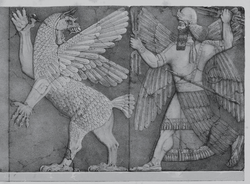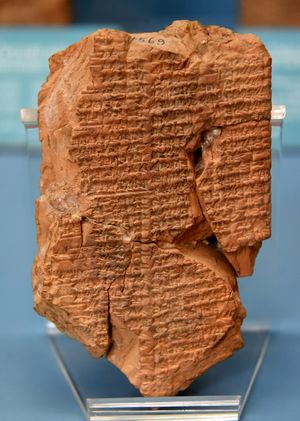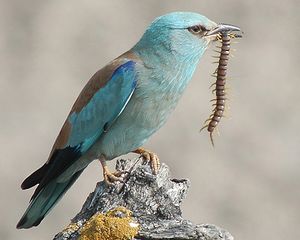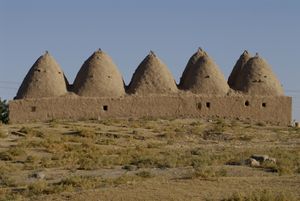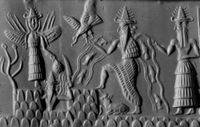دوموزيد
| دُموزيد Dumuzid | |
|---|---|
إله الرعاة والخصوبة | |
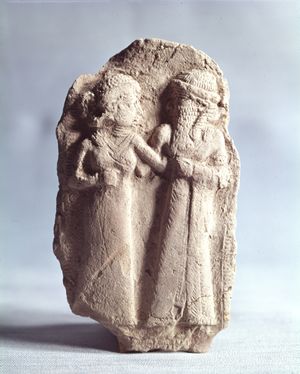 | |
| المسكن | السماء (لنصف العام) كور (للنصف الآخر) |
| معلومات شخصية | |
| الأبوان | سرتور وأب غير معروف |
| الأشقاء | گشتإنانـّا (شقيقة)، أماشيلاما (ليست في المعتاد، ولكن في بعض النصوص يقال أنها شقيقته) |
| القرين | إينانـّا (عـُرِفت لاحقاً بإسم عشتار) |
| الآلهة المكافئة | |
| المكافئ اليوناني | أدونيس |
| المكافئ السامية الشرقية | تموز |
| المكافئ المشرق | تموز/أدونيس |
| جزء من سلسلة مقالات عن |
| ديانة الرافدين |
|---|
|
|
دموزيد [أ] عـُرِف لاحقاً بالصيغة البديلة تمّوز Tammuz؛ [ب]، هو اسم إله الطعام والخضروات السومري، وكان يُعبد أيضاً في دول بلاد الرافدين اللاحقة، أكاديا، آشور وبابل.
ancient Mesopotamian god associated with shepherds, who was also the primary consort of the goddess Inanna (later known as Ishtar). In Sumerian mythology, Dumuzid's sister was Geshtinanna, the goddess of agriculture, fertility, and dream interpretation. In the Sumerian King List, Dumuzid is listed as an antediluvian king of the city of Bad-tibira and also an early king of the city of Uruk. In the Sumerian poem Inanna Prefers the Farmer, Dumuzid competes against the farmer Enkimdu for Inanna's hand in marriage. In Inanna's Descent into the Underworld, Dumuzid fails to mourn Inanna's death and, when she returns from the Underworld, she allows the galla demons to drag him down to the Underworld as her replacement. Inanna later regrets this decision and decrees that Dumuzid will spend half the year in the Underworld, but the other half of the year with her, while his sister Geshtinanna stays in the Underworld in his place, thus resulting in the cycle of the seasons.
Gilgamesh references Tammuz in Tablet VI of the Epic of Gilgamesh as one of Ishtar's past lovers, who was turned into an allalu bird with a broken wing. Dumuzid was associated with fertility and vegetation and the hot, dry summers of Mesopotamia were believed to be caused by Dumuzid's yearly death. During the month in midsummer bearing his name, people all across Mesopotamia would engage in public, ritual mourning for him. During the late twentieth century, scholars widely thought that, during the Sumerian Akitu festival, kings may have established their legitimacy by taking on the role of Dumuzid and engaging in ritualized sexual intercourse with the high priestess of Inanna as part of a sacred marriage ceremony. This notion is now generally rejected by scholars as a misinterpretation of Sumerian literary texts. The cult of Dumuzid was later spread to the Levant and to Greece, where he became known under the West Semitic name Adonis.
The cult of Ishtar and Tammuz continued to thrive until the eleventh century AD and survived in parts of Mesopotamia as late as the eighteenth century. Tammuz is mentioned by name in the Book of Ezekiel and possibly alluded to in other passages from the Hebrew Bible. In late nineteenth and early twentieth century scholarship of religion, Tammuz was widely seen as a prime example of the archetypal dying-and-rising god, but the discovery of the full Sumerian text of Inanna's Descent in the mid-twentieth century appeared to disprove the previous scholarly assumption that the narrative ended with Dumuzid's resurrection and instead revealed that it ended with Dumuzid's death. However, the rescue of Dumuzid from the underworld and his ascension to Heaven was later found in the text Return of Dumuzid, translated in 1963. Despite this, the existence of the "dying-and-rising god" archetype has been largely rejected by modern scholars.[بحاجة لمصدر]
العبادة
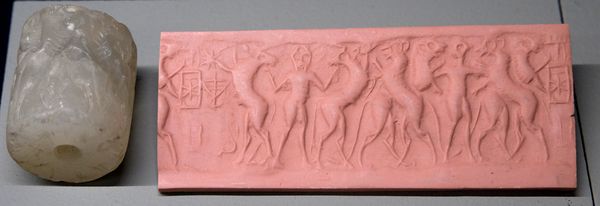

The Assyriologists Jeremy Black and Anthony Green describe the early history of Dumuzid's cult as "complex and bewildering".[4] According to the Sumerian King List (ETCSL 2.1.1), Dumuzid was the fifth antediluvian king of the city of Bad-tibira.[4] Dumuzid was also listed as an early king of Uruk,[4] where he was said to have come from the nearby village of Kuara[4] and to have been the consort of the goddess Inanna.[4] As Dumuzid sipad ("Dumuzid the Shepherd"), Dumuzid was believed to be the provider of milk,[5] which was a rare, seasonal commodity in ancient Sumer due to the fact that it could not easily be stored without spoiling.[5]
In addition to being the god of shepherds, Dumuzid was also an agricultural deity associated with the growth of plants.[6][5] Ancient Near Eastern peoples associated Dumuzid with the springtime, when the land was fertile and abundant,[6][5] but, during the summer months, when the land was dry and barren, it was thought that Dumuzid had "died".[6][5] During the month of Dumuzid, which fell in the middle of summer, people all across Sumer would mourn over his death.[4][5] This seems to have been the primary aspect of his cult.[4] In Lagash, the month of Dumuzid was the sixth month of the year.[4] This month and the holiday associated with it was later transmitted from the Sumerians to Babylonians and other East Semitic peoples,[4] with its name transcribed into those languages as Tammuz.[4] A ritual associated with the Ekur temple in Nippur equates Dumuzid with the snake-god Ištaran, who in that ritual, is described as having died.[7]
Dumuzid was also identified with the god Ama-ušumgal-ana (𒀭𒂼𒃲𒁔𒀭𒈾 dama-ušumgal-an-na),[4] who was originally a local god worshipped in the city of Lagash.[4] In some texts, Ama-ušumgal-ana is described as a heroic warrior.[4] As Ama-ušumgal-ana, Dumuzid is associated with the date palm and its fruits.[5] This aspect of Dumuzid's cult was always joyful in character[5] and had no associations with the darker stories involving his death.[5] To ancient Mesopotamian peoples, the date palm represented stability,[5] because it was one of the few crops that could be harvested all year, even during the dry season.[5] In some Sumerian poems, Dumuzid is referred to as "my Damu", which means "my son".[4][5] This name is usually applied to him in his role as the personification of the power that causes the sap to rise in trees and plants.[5] Damu is the name most closely associated with Dumuzid's return in autumn after the dry season has ended.[5] This aspect of his cult emphasized the fear and exhaustion of the community after surviving the devastating summer.[5]
Dumuzid had virtually no power outside of his distinct realm of responsibilities.[5] Very few prayers addressed to him are extant[5] and, of those that are, almost all of them are simply requests for him to provide more milk, more grain, more cattle, etc.[5] The sole exception to this rule is a single Assyrian inscription in which a man requests Tammuz that, when he descends to the Underworld, he should take with him a troublesome ghost who has been haunting him.[5] The cult of Tammuz was particularly associated with women, who were the ones responsible for mourning his death.[6] The custom of planting miniature gardens with fast-growing plants such as lettuce and fennel, which would then be placed out in the hot sun to sprout before withering in the heat, was a well-attested custom in ancient Greece associated with the festival of Adonia in honor of Adonis, the Greek version of Tammuz;[8][9][10] some scholars have argued based on references in the Hebrew Bible that this custom may have been a continuation of an earlier oriental practice.[10] The same women who mourned the death of Tammuz also prepared cakes for his consort Ishtar, the Queen of Heaven.[6] These cakes would be baked in ashes[6] and several clay cake molds discovered at Mari, Syria reveal that they were also at least sometimes shaped like naked women.[6]
According to the scholar Samuel Noah Kramer, towards the end of the third millennium BC, kings of Uruk may have established their legitimacy by taking on the role of Dumuzid as part of a "sacred marriage" ceremony.[11] This ritual lasted for one night on the tenth day of the Akitu,[11][12] the Sumerian new year festival,[12] which was celebrated annually at the spring equinox.[11] As part of the ritual, it was thought that the king would engage in ritualized sexual intercourse with the high priestess of Inanna, who took on the role of the goddess.[11][12] In the late twentieth century, the historicity of the sacred marriage ritual was treated by scholars as more-or-less an established fact,[13] but in recent years, largely due to the writings of Pirjo Lapinkivi, some scholars have rejected the notion of an actual sex ritual, instead seeing "sacred marriage" as a symbolic rather than a physical union.[13]
الأساطير
السومرية
زواج دموزيد و إنانـّا
The poem Inanna Prefers the Farmer (ETCSL 4.0.8.3.3) begins with a rather playful conversation between Inanna and her brother Utu, who incrementally reveals to her that it is time for her to marry.[14][15] Dumuzid comes to court her, along with a farmer named Enkimdu.[14] At first, Inanna prefers the farmer,[14] but Utu and Dumuzid gradually persuade her that Dumuzid is the better choice for a husband, arguing that, for every gift the farmer can give to her, the shepherd can give her something even better.[14] In the end, Inanna marries Dumuzid.[14] The shepherd and the farmer reconcile their differences, offering each other gifts.[14] Samuel Noah Kramer compares the myth to the Biblical story of Cain and Abel because both myths center around a farmer and a shepherd competing for divine favor and, in both stories, the deity in question ultimately chooses the shepherd.[14]
A vast number of erotic love poems celebrating the consummation of Inanna and Dumuzid have survived.[15][16] Two excerpts from a representative example are translated below:
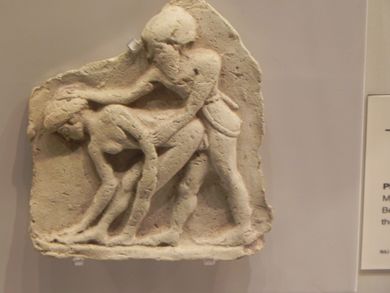
| Transliterated Sumerian text (ETCSL 4.08.16) | English translation by Samuel Noah Kramer and Diane Wolkstein |
gal4-la jar-ra? ne-en GAG X [...] |
My vulva, the horn, |
الوفاة
السرد الرئيسية

Towards the end of the epic poem Inanna's Descent into the Underworld (ETCSL 1.4.1), Dumuzid's wife Inanna escapes from the Underworld,[14] but is pursued by a horde of galla demons, who insist that someone else must take her place in the Underworld.[14] They first come upon Inanna's sukkal Ninshubur and attempt to take her,[14][15] but Inanna stops them, insisting that Ninshubur is her loyal servant and that she had rightfully mourned for her while she was in the Underworld.[14][15] They next come upon Shara, Inanna's beautician, who is still in mourning.[14][15] The demons attempt to take him, but Inanna insists that they may not, because he had also mourned for her.[14][15] The third person they come upon is Lulal, who is also in mourning.[14][15] The demons try to take him, but Inanna stops them once again.[14][15] Finally, they come upon Dumuzid, who is lavishly clothed and resting beneath a tree, or sitting on Inanna's throne, entertained by slave-girls.[15] Inanna, displeased, decrees that the demons shall take him, using language which echoes the speech Ereshkigal gave while condemning her.[15] The demons then drag Dumuzid down to the Underworld.[15]
The Sumerian poem The Dream of Dumuzid (ETCSL 1.4.3) begins with Dumuzid telling Geshtinanna about a frightening dream he has experienced.[15][ت] Then the galla demons arrive to drag Dumuzid down into the Underworld as Inanna's replacement. Dumuzid flees and hides. The galla demons brutally torture Geshtinanna in an attempt to force her to tell them where Dumuzid is hiding. Geshtinanna, however, refuses to tell them where her brother has gone. The galla go to Dumuzid's unnamed "friend", who betrays Dumuzid, telling the galla exactly where Dumuzid is hiding. The galla capture Dumuzid, but Utu, the god of the Sun, who is also Inanna's brother, rescues Dumuzid by transforming him into a gazelle.[15] Eventually, the galla recapture Dumuzid and drag him down into the Underworld.[17][15]

In the Sumerian poem The Return of Dumuzid, which begins where The Dream of Dumuzid ends, Geshtinanna laments continually for days and nights over Dumuzid's death, joined by Inanna, who has apparently experienced a change of heart, and Sirtur, Dumuzid's mother.[15] The three goddesses mourn continually until a fly reveals to Inanna the location of her husband.[15] Together, Inanna and Geshtinanna go to the place where the fly has told them they will find Dumuzid.[15] They find him there and Inanna decrees that, from that point onwards, Dumuzid will spend half of the year with her sister Ereshkigal in the Underworld and the other half of the year in Heaven with her, while Geshtinanna takes his place in the Underworld.[18][19][15]
نسخ أخرى
Other texts describe different and contradictory accounts of Dumuzid's death.[20] The text of the poem Inanna and Bilulu (ETCSL 1.4.4), discovered at Nippur, is badly mutilated[21] and scholars have interpreted it in a number of different ways.[21] The beginning of the poem is mostly destroyed,[21] but seems to be a lament.[21] The intelligible part of the poem describes Inanna pining after her husband Dumuzid, who is in the steppe watching his flocks.[21] Inanna sets out to find him.[21] After this, a large portion of the text is missing.[21] When the story resumes, Inanna is being told that Dumuzid has been murdered.[21] Inanna discovers that the old bandit woman Bilulu and her son Girgire are responsible.[13] She travels along the road to Edenlila and stops at an inn, where she finds the two murderers.[21] Inanna stands on top of a stool[21] and transforms Bilulu into "the waterskin that men carry in the desert",[21][4][13] forcing her to pour the funerary libations for Dumuzid.[21]
Dumuzid and Geshtinanna begins with demons encouraging Inanna to conquer the Underworld.[20] Instead, she hands Dumuzid over to them.[20] They put Dumuzid's feet, hands, and neck in the stocks[20] and torture him using hot pokers.[20] They strip him naked, do "evil" to him, and cover his face with his own garment.[20] Finally, Dumuzid prays to Utu for help.[20] Utu transforms Dumuzid into a creature that is part eagle and part snake, allowing him to escape back to Geshtinanna.[20] In the text known as The Most Bitter Cry, Dumuzid is chased by the "seven evil deputies of the netherworld"[20] and, as he is running, he falls into a river.[20] Near an apple tree on the other bank, he is dragged into the Underworld,[20] where everything simultaneously "exists" and "does not exist", perhaps indicating that they exist in insubstantial or immaterial forms.[20]
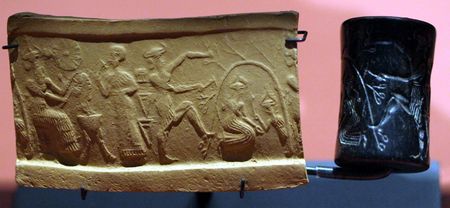
A collection of lamentations for Dumuzid entitled In the Desert by the Early Grass describes Damu, the "dead anointed one", being dragged down to the Underworld by demons,[20] who blindfold him, tie him up, and forbid him from sleeping.[20] Damu's mother tries to follow him into the Underworld,[20] but Damu is now a disembodied spirit, "lying in" the winds, "in the lightnings and in tornadoes".[20] Damu's mother is also unable to eat the food or drink the water in the Underworld, because it is "bad".[20] Damu travels along the road of the Underworld and encounters various spirits.[20] He meets the ghost of a small child, who tells him that it is lost;[20] the ghost of a singer agrees to accompany the child.[20] Damu asks the spirits to send a message to his mother, but they cannot because they are dead and the living cannot hear the dead's voices.[20] Damu, however, manages to tell his mother to dig up his blood and chop it into pieces.[20] Damu's mother gives the congealed blood to Damu's sister Amashilama, who is a leech.[20] Amashilama mixes the congealed blood into a brew of beer, which Damu must drink in order to be restored to life.[20] Damu, however, realizes that he is dead and declares that he is not in the "grass which shall grow for his mother again", nor in the "waters which will rise".[20] Damu's mother blesses him[20] and Amashilama dies to join him in the Underworld.[20] She tells him that "the day that dawns for you will also dawn for me; the day you see, I shall also see",[20] referring to the fact that day in the world above is night in the Underworld.[20]
الأكـَّدية
In the myth of Adapa, Dumuzid and Ningishzida are the two doorkeepers of Anu, the god of the heavens,[24][4][22] who speak out in favor of Adapa, the priest of Ea, as he stands trial before Anu.[24][22] In Tablet VI of the standard Akkadian Epic of Gilgamesh, Ishtar (Inanna) attempts to seduce the hero Gilgamesh,[22][13] but he rebuffs her, reminding her that she had struck Tammuz (Dumuzid), "the lover of [her] youth", decreeing that he should "keep weeping year after year".[22][13] Gilgamesh describes Tammuz as a colorful allalu bird (possibly a European or Indian roller),[22][23] whose wing has been broken and now spends all his time "in the woods crying 'My wing!'" (Tablet VI, section ii, lines 11-15).[22] Gilgamesh may be referring to an alternative account of Dumuzid's death, different from the ones recorded in extant texts.[13]
Anton Moortgat has interpreted Dumuzid as the antithesis of Gilgamesh:[25] Gilgamesh refuses Ishtar's demand for him to become her lover, seeks immortality, and fails to find it;[25] Dumuzid, by contrast, accepts Ishtar's offer and, as a result of her love, is able to spend half the year in Heaven, even though he is condemned to the Underworld for the other half.[25] Mehmet-Ali Ataç further argues that the "Tammuz model" of immortality was far more prevalent in the ancient Near East than the "Gilgamesh model".[25] In a chart of antediluvian generations in Babylonian and Biblical traditions, William Wolfgang Hallo associates Dumuzid with the composite half-man, half-fish counselor or culture hero (Apkallu) An-Enlilda, and suggests an equivalence between Dumuzid and Enoch in the Sethite Genealogy given in Genesis chapter 5.[26]
يعتبر موت وقيامة الاله تموز (دموزي ) أحد الطقوس التراجيدية المهمة بسماته الاسطورية والطقوسية والفلسفية ، فهو الخزين التراجيدي في روح الإنسان القديم في وادي الرافدين . ولحجم الاضطهاد والعذاب الذي تعرض له الإله ( دموزي ـ تموز ) و علاقة حبيبته الآلهة إنانا – عشتار ودورها الملتبس بهذا الموت المأساوي أدى الى أن تمتلئ المثيولوجيا والآداب السومرية والبابلية بمناحات واساطير وملاحم وطقوس تعزية خاصة بمآسي آلهة الخصب الشهيرة هذه وغيابها عن الحياة، ومن ثم قيامتها من جديد ، و يعتبر كل هذا حتى الان من أرقى وأغنى ما كتب في مثيولوجيا شعوب وادي الرافدين.[27]
ومن خلال هذه القصائد والأدبيات الدينية والاساطير والطقوس تكثفت معرفتنا عن إختطاف إله الخصب دموزي السومري ـ تموز (في الحضارة البابلية )، من قبل شياطين العالم الاسفل ونواح الالهة السومرية إنانا على زوجها وحبيبها وأخيها بعد ان سلمته هي للموت . لكن الالهة عشتار ( الامتداد البابلي للآلهة إنانا السومرية ) أرادت ان تكفر عن خطئها حيث بدون تموز لا يتم أي إخصاب بمختلف أشكاله سواء في الطبيعة او لدى الانسان ، وهذا يعني القحط والجفاف والموت في الحياة مما دفعها للهبوط الى عالم الموت للبحث عنه وتحمل المآسي والصعوبات التي رافقت رحلتها . وتعبيرا عن ضرورة الخصب في الكون مارس شعب وادي الرافدين الحزن الجماعي على دموزي السومري ـ تموز البابلي و مشاركة الالهة إنانا ـ عشتار في مصابها على حبيبها او نصفها الاخر. ويعد هذا الطقس نقيض طقس الزواج المقدس ،ولكنه مكمل له في ذات الوقت . فعندما سلمت الالهة إنانا السومرية الاله دموزي كبديل لها ، فان الالهة عشتار في النسخة البابلية هي التي هبطت من جديد لإنقاذه و يعد هذا إنقاذاً لحياة الكائنات والطبيعة وكل مايمت بصلة بالخصب .
وقد بدأت مأساة الاله تموز عندما وقع بين أيدي شياطين ( الجلا ) وهي مخلوقات لاتعرف الرحمة وتقتات على االطين ( انتم العفاريت الذين لا ام لهم ولا اب ولا إخت ولا زوجة ولا ولد / الذين يرفرفون حائمين في السماء والارض مثل رؤساء الحرس /انتم العفاريت الذين يتشبثون بجنب الانسان /الذين لا يعرفون ما الفضل ولا يعرفون الخير و الشر /) وتنفيذا لتطبيق قاموا بشد وثاقه في الحال وعذبوه تمهيدا لنزوله في جحيم الموت ، وبعد توسلات كثيره من قبله لجميع الالهة لمساعدته ، و توسلاته الى صهره إله الشمس :
( ايه أوتو ، أنا صديقك ، أنا الفتى الذي تعرفه /إتخذت اختك زوجا / إستبدلتني لأكون عوضا منها في العالم الاسفل / إيه أوتو ، انت القاضي العدل ، لاتدعني أموت ، / غير يدي / بدل صورتي / دعني افلت من شياطيني ، فلا يمسكوا بي ، / مثل حية ساجال سوف اجتاز مروج الروابي ، / سوف أنقل روحي الى بيت اختي جشت نانا ) ويستجيب إله الشمس أوتو لإنقاذه ويحوله الى ثعبان يختفي في الحقول . الاله المنفي تموز مطاردا ، بدون سقف يحميه او زاوية يركن اليها ، مامن دكة يتكأ عليها ، مامن باب يصدر عنه الريح ما من مكان يحتمي فيه . منفي ، مطارد وحيد هو ، لا يملك سوى جذوة روحه ، هو ومصيره هذا الاله المنفي سيد البلاد المعذب. ويضل هائما حتى يصل الى بيت اخته ، وعندما تراه تصدر نواح مر ، نواح لا مثيل له لانها كعرافة ترى نهايته المستقبلية الاليمة .( جشتي نانا حدقت في أخيها،/ خدشت وجنتيها ، مزقت فمها /…… شقت ثيابها /صدر عنها نواح مر على السيد المعذب / اواه يااخي ، أواه ،أيها الفتى الذي لم تكن ايامه طويلة /أواه يااخي الفتى الذي لازوج له ولا ولد /أواه يا أخي الفتى الذي لا صديق له ولا رفيق / أواه يا أخي الفتى الذي لا يجلب العزاء لأمه /)
وأثناء نوم الاله الهارب من قتلته ، يرى كابوسا مخيفا له دلالاته الرمزية كما يحدثنا الشاعر السومري ـ البابلي بكلمات شعرية معبرة و موجزة وذات بعد تراجيدي ، فمن خلال اللقطة الخاطفة ذات الايقاع السريع كما في السينما المعاصرة ، يكثف لنا الشاعر الصورة الدرامية التي تعبر عن مأساوية النهاية الحتمية لمصير الاله ( استيقظ ، كان حلما / اضطرب ، كان رؤيا ،/ فرك عينيه ، انتابه دوار )
وكما يرى الاله في حلمه فان الأسل يتكاثف من حوله فقط هنالك حزمة من القصب تحني راسها امامه . وعلى مثواه المقدس لايسكب ماء ، وطاسة اللبن المقدسة المعلقة الى وتد تسقط وتنكسر ، ومحجنة (عصا ) الراعي دموزي تختفي ، وبازا يمسك حملا ببراثينه ، وماشية الاله تجرجر لحاها اللازوردية على التراب وتدب على الارض بقوائم ملتوية . ومامن لبن يسكب والطاسة محطمة . دموزي لن يعيش الهدوؤء بعد الان ، فحضيرة الغنم في مهب الريح .
ان رموز هذا الحلم تدلل جميعها على صفات الاله باعتباره راعيا ، ولذلك فان الشاعر استخدم كلمات مكثفة الصورة وترمز لطبيعة مثل هذه الحياة . وحلم الاله يظهر لنا الحالة التراجيدية والحزن الذي يلف شغاف قلبه . وعندما تبدأ (جشتي نانا ) بتأويل حلم أخيها وتفسيره يكون التأويل أكثر رعبا وتراجيدية من الحلم ذاته . حيث تنبئه بان الاسَل الذي يلتف من حوله هو سفاحون سينقضون عليه والأشرار سوف يرعبونه وحظيرة الغنم سوف تغدو خرابا . ولكن تمسك الاله دموزي ـ تموز بالحياة يدفعه الى الاختباء في مكان سري آخر لايعلم به سوى اخته بعد ان يستحلفها ألا تدلهم على مكان مخبئه ،( سوف اختبئ بين النباتات الكبيرة ، لاتقولي اين أنا / سوف اختبئ بين أخاديد " أرالي "، لاتقولي اين أنا ) فتعده بذلك . ( إذا قلت اين مخبؤك ، فلتاكلني كلابك .)
لكن شياطين الجلا يتشاورون فيما بينهم عن مكان اختباؤه(من ذا الذي يرى انسانا تملكه الخوف يعيش بسلام /ألا، فلنمتنع عن الذهاب الى بيت صديقه، وعن الذهاب الى بيت صهره/فالنمضي باحثين عن الراعي في بيت جشتي نانا) وعندما يصلون الى هناك يعذبونها من اجل ان تدلهم عليه ، لكن دون جدوى (دلينا أين يختبأ أخوك ، قالوا لها ، لكنها لم تدلهم ،/ جاءوا بالسماء قريبا منها ، ووضعوا الارض في حجرها ، لكنها لم تدلهم ./ جاءوا بالأرض قريبا مزقوها ، لكنها لم تدلهم ، / جاءوا بها قريبا …… بعثروها فوق ملابسها ، لكنها لم تدلهم / صبوا في حجرها قاراً ، لكنها لم تدلهم / لم يجدوا دموزي في بيت جشتي نانا / ) وهكذا تفي أخت الاله بوعدها . إلا ان تموز يشعر بالذنب بسبب الآلام التي عانتها اخته ( إن اختبأت في المدن ، أكون جلبت نهاية لأختي ./ ) فيسمح لمطارديه ان يمسكوا به بطريقة ما . وعندما يتم هذا يشعر بالخوف من الموت فييتوسل الاله أوتو من جديد كي يحيله الى غزال ، غير ان الشياطين الاشرار لديهم مهمة تنفيذ قانون العالم الاسفل ولابد ان يجدوه فيطاردونه ةيفلت ايضا منهم وهو دلالة على الصراع بين قوى الاخصاب وقوى الموت . وفي الختام يمسكون به وهو مختبئ في حظيرته في الصحراء . يعذبونه من اجل ان يرسلوه الى عالم الموت الابدي . وبهذا يتحقق كابوسه . لكن اخته تقوم بالتضحية الكبرى عندما تعرض على شياطينه ان تحل محله في عالم اللاعودة كبديل عنه . وعقابا لدموزي الذي حاول الهرب من قدر العقاب يتم الحكم عليه بان يقيم نصف سنة في عالم الاموات وتأخذ أخته مكانه في النصف الثاني . وعند موت دموزي يعم الجفاف في الكون . عندها يمتلأ قلب الالهة إنانا ـ عشتار حزنا على حبيبها فتصاب بالندم على كونها هي السبب لهذا الجفاف والخراب الذي عم مدينتها ، بتسليمها اله الخصب الى الموت . فيبدأ شعب وادي الرافدين بممارسة طقوس الحزن مع آلهته إنانا ، وطقس الندم الجمعي على الاله دموزي ـ تموز حتى تتم قيامته من جديد ، عندها يبدأ الخصب في الربيع والصيف بعد الموت والجفاف وهكذا تبدأ دورة الحياة.
ومن خلال هذه الوقائع السردية لموت وقيامة الاله يمكننا القول بان :
الاختلاف الجوهري لهذا الطقس يكمن في كونه يعالج فكرة اساسية وهي الصراع المستميت بين الحياة والموت أضافة الى التطرق لبعض المشاكل الانسانية الاخرى مثل الدهاء والمكر في التخلص من الاعداء ، والغيرة والتضحية والحب العميق بين الاخت والاخ ، وقد لاحظنا تنوع المكان الذي حدثت فيه الاحداث ، كالمعبد ومجمع الالهة والحقول والصحارى وعالم الموت . التباين في سلوك ومصائر الشخصيات ، وقد اتسمت شخصية الاله تموز واخته جشتي نانا بالتمسك برباط الاخوة القدسي والحنان والرقة مما اضفى عليهما بعدا انسانيا عميقا.
كم تبدو معاناة الاله دموزي ـ تموز متشابه في الكثير من فصولها مع عذابات الانسان العراقي في جحيمه المعاصر سواء كان في فيافي وسهوب وطنه أم في منفاه.
العبادة اللاحقة
في التوراة

The cult of Ishtar and Tammuz may have been introduced to the Kingdom of Judah during the reign of King Manasseh[13] and the Old Testament contains numerous allusions to them.[13] Ezekiel 8:14 mentions Tammuz by name:[30][13][28][29] "Then he brought me to the door of the gate of the Lord's house which was toward the north; and, behold, there sat women weeping for Tammuz. Then said he unto to me, 'Hast thou seen this, O son of man? turn thee yet again, and thou shalt see greater abominations than these."[13]
Ezekiel's testimony is the only direct mention of Tammuz in the Hebrew Bible,[31][29] but the cult of Tammuz may also be alluded to in Isaiah 17:10–11 9:[31][29]
"Because thou hast forgotten the God of thy salvation, and hast not been mindful of the rock of thy strength, therefore shalt thou plant pleasant plants, and shalt set it with strange slips: In the day shalt thou make thy plant to grow, and in the morning shalt thou make thy seed to flourish: but the harvest shall be a heap in the day of grief and of desperate sorrow."
This passage may be describing the miniature gardens that women would plant in honor of Tammuz during his festival.[10] Isaiah 1:29–30 9, Isaiah 65:3 9, and Isaiah 66:17 9 all denounce sacrifices made "in the gardens", which may also be connected to the cult of Tammuz.[10] Another possible allusion to Tammuz occurs in Daniel 11:37 9:[31][10][29] "Neither shall he regard the God of his fathers, nor the desire of women, nor regard any god: for he shall magnify himself above all." The subject of this passage is Antiochus IV Epiphanes[10] and some scholars have interpreted the reference to the "one desired by women" in this passage as an indication that Antiochus may have persecuted the cult of Tammuz.[10] There is no external evidence to support this reading, however,[10] and it is much more probable that this epithet is merely a jibe at Antiochus's notorious cruelty towards all the women who fell in love with him.[10]
The Hebrew Bible also contains references to Tammuz's consort Inanna-Ishtar.[13] Jeremiah 7:18 9 and Jeremiah 44:15–19 9 mention "the Queen of Heaven", who is probably a syncretism of Inanna-Ishtar and the West Semitic goddess Astarte.[13][32][31][6] The Song of Songs bears strong similarities to the Sumerian love poems involving Inanna and Dumuzid,[13] particularly in its usage of natural symbolism to represent the lovers' physicality.[13] of Songs%206:10&verse=9&src=! Song of Songs 6:10 9 ("Who is she that looketh forth as the morning, fair as the moon, clear as the sun, and terrible as an army with banners?") is almost certainly a reference to Inanna-Ishtar.[33]
تم رصد هذا النوع من احتفالات الحداد على باب معبد القدس في رؤيا النبي الإسرائيلي حزقيال، والتي هي بمثابة نبوءة توراتية يعبر عن رسالة الرب لشعبه المرتد لعبادته الأصنام:
- "جاءَ بِي إِلَى مَدْخَلِ بَابِ بَيْتِ الرَّبِّ الَّذِي مِنْ جِهَةِ الشِّمَالِ، وَإِذَا هُنَاكَ نِسْوَةٌ جَالِسَاتٌ يَبْكِينَ عَلَى تَمُّوزَ. فَقَالَ لِي: «أَرَأَيْتَ هذَا يَا ابْنَ آدَمَ؟ بَعْدُ تَعُودُ تَنْظُرُ رَجَاسَاتٍ أَعْظَمَ مِنْ هذِهِ»." —Ezekiel 8:14-15
من الممكن تماماً أن تكون عبادة تموز بين اليهود الآخرين لم تكن تتعارض مع يهويسم.[34]
شهادة حزقيال هي الإشارة الوحيدة المباشرة لتموز في التوراة، على الرغم من وجود إشارات غير مباشرة لتموز في سفر أشعيا، ودانيال.[35]
القِدم الكلاسيكي

The myth of Inanna and Dumuzid later became the basis for the Greek myth of Aphrodite and Adonis.[36][37][8] The Greek name Ἄδωνις (Adōnis, [ádɔːnis]) is derived from the Canaanite word ʼadōn, meaning "lord".[38][8] The earliest known Greek reference to Adonis comes from a fragment of a poem by the Lesbian poetess Sappho, dating to the seventh century BC,[36] in which a chorus of young girls asks Aphrodite what they can do to mourn Adonis's death.[36] Aphrodite replies that they must beat their breasts and tear their tunics.[36] Later rescensions of the Adonis legend reveal that he was believed to have been slain by a wild boar during a hunting trip.[37][8] According to Lucian's De Dea Syria,[37] each year during the festival of Adonis, the Adonis River in Lebanon (now known as the Abraham River) ran red with blood.[37]
In Greece, the myth of Adonis was associated with the festival of the Adonia, which was celebrated by Greek women every year in midsummer.[8][39] The festival, which was evidently already celebrated in Lesbos by Sappho's time,[8] seems to have first become popular in Athens in the mid-fifth century BC.[8] At the start of the festival, the women would plant a "garden of Adonis",[8] a small garden planted inside a small basket or a shallow piece of broken pottery containing a variety of quick-growing plants, such as lettuce and fennel, or even quick-sprouting grains such as wheat and barley.[8][9] The women would then climb ladders to the roofs of their houses,[8] where they would place the gardens out under the heat of the summer sun.[8] The plants would sprout in the sunlight,[8] but wither quickly in the heat.[8] Then the women would mourn and lament loudly over the death of Adonis,[8] tearing their clothes and beating their breasts in a public display of grief.[8] The third century BC poet Euphorion of Chalcis remarked in his Hyacinth that "Only Cocytus washed the wounds of Adonis".[40]
الاستمرار في العصر المسيحي

Traditional Mesopotamian religion began to gradually decline between the third and fifth centuries AD as ethnic Assyrians converted to Christianity.[42] Nonetheless, the cult of Ishtar and Tammuz managed to survive in parts of Upper Mesopotamia.[28] The Church Father Jerome records in a letter dated to the year 395 AD that "Bethlehem... belonging now to us... was overshadowed by a grove of Tammuz, that is to say, Adonis, and in the cave where once the infant Christ cried, the lover of Venus was lamented."[41] This same cave later became the site of the Church of the Nativity.[41] The church historian Eusebius, however, does not mention pagans having ever worshipped in the cave,[41] nor do any other early Christian writers.[41] Peter Welten has argued that the cave was never dedicated to Tammuz[41] and that Jerome misinterpreted Christian mourning over the Massacre of the Innocents as a pagan ritual over Tammuz's death.[41] Joan E. Taylor has countered this contention by arguing that Jerome, as an educated man, could not have been so naïve as to mistake Christian mourning over the Massacre of the Innocents as a pagan ritual for Tammuz.[41]
During the sixth century AD, some early Christians in the Middle East borrowed elements from poems of Ishtar mourning over the death of Tammuz into their own retellings of the Virgin Mary mourning over the death of her son Jesus.[28][33] The Syrian writers Jacob of Serugh and Romanos the Melodist both wrote laments in which the Virgin Mary describes her compassion for her son at the foot of the cross in deeply personal terms closely resembling Ishtar's laments over the death of Tammuz.[28]
Tammuz is the month of July in Iraqi Arabic and Levantine Arabic (see Arabic names of calendar months), as well as in the Assyrian calendar and Jewish calendar,[44] and references to Tammuz appear in Arabic literature from the 9th to 11th centuries AD.[43] In what purports to be a translation of an ancient Nabataean (here meaning Aramaean) text by Qūthāmā the Babylonian, Ibn Wahshiyya (c. 9th-10th century AD), adds information on his own efforts to ascertain the identity of Tammuz, and his discovery of the full details of the legend of Tammuz in another Nabataean book: "How he summoned the king to worship the seven (planets) and the twelve (signs) and how the king put him to death several times in a cruel manner Tammuz coming to life again after each time, until at last he died; and behold! it was identical to the legend of St. George."[45] Ibn Wahshiyya also adds that Tammuz lived in Babylonia before the coming of the Chaldeans and belonged to an ancient Mesopotamian tribe called Ganbân.[43] On rituals related to Tammuz in his time, he adds that the Sabaeans in Harran and Babylonia still lamented the loss of Tammuz every July, but that the origin of the worship had been lost.[43]
In the tenth century AD, the Arab traveler Al-Nadim wrote in his Kitab al-Fehrest that "All the Sabaeans of our time, those of Babylonia as well as those of Harran, lament and weep to this day over Tammuz at a festival which they, more particularly the women, hold in the month of the same name."[28] Drawing from a work on Syriac calendar feast days, Al-Nadim describes a Tâ'ûz festival that took place in the middle of the month of Tammuz.[43] Women bewailed the death of Tammuz at the hands of his master who was said to have "ground his bones in a mill and scattered them to the wind."[43] Consequently, women would forgo the eating of ground foods during the festival time.[43] The same festival is mentioned in the eleventh century by Ibn Athir, who recounts that it still took place every year at the appointed time along the banks of the Tigris river.[43] The cult of Ishtar and Tammuz still existed in Mardin as late as the eighteenth century.[42] Tammuz is still the name for the month of July in Iraqi Arabic.[4]
كإله "يموت ويقوم"
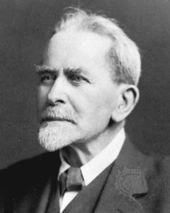
The late nineteenth-century Scottish anthropologist Sir James George Frazer wrote extensively about Tammuz in his monumental study of comparative religion The Golden Bough (the first edition of which was published in 1890)[46][49] as well as in later works.[47] Frazer claimed that Tammuz was just one example of the archetype of a "dying-and-rising god" found throughout all cultures.[47][46][48] Frazer and others also saw Tammuz's Greek equivalent Adonis as a "dying-and-rising god".[47][46][48] Origen discusses Adonis, whom he associates with Tammuz, in his Selecta in Ezechielem ( “Comments on Ezekiel”), noting that "they say that for a long time certain rites of initiation are conducted: first, that they weep for him, since he has died; second, that they rejoice for him because he has risen from the dead (apo nekrôn anastanti)" (cf. J.-P. Migne, Patrologiae Cursus Completus: Series Graeca, 13:800).
Tammuz's categorization as a "dying-and-rising god" was based on the abbreviated Akkadian redaction of Inanna's Descent into the Underworld, which was missing the ending.[48][49] Since numerous lamentations over the death of Dumuzid had already been translated, scholars filled in the missing ending by assuming that the reason for Ishtar's descent was because she was going to resurrect Dumuzid and that the text could therefore be assumed to end with Tammuz's resurrection.[48] Then, in the middle of the twentieth century, the complete, unabridged, original Sumerian text of Inanna's Descent was finally translated,[48][49] revealing that, instead of ending with Dumuzid's resurrection as had long been assumed, the text actually ended with Dumuzid's death.[48][49] The rescue of Dumuzid from the underworld and his ascension to Heaven was later found in the text Return of Dumuzid, translated in 1963. Biblical scholars Eddy and Boyd argued in 2007 that this text does not technically describe a triumph over death because Dumuzid must be replaced in the underworld by his sister, thus reinforcing the "inalterable power of the realm of the dead".[48] However, other scholars have cited this as a clear example of a god who was previously dead and subsequently resurrected.[50][51]
في المصادر العربية
تموز هو شهر يوليو باللهجة العراقية والشامية (انظر أسماء شهور التقويم)،[52] وظهرت إشارة لتموز في الأدب العربي من القرن 9 حتى 11 الميلادي.[43] في ترجمة النص النبطي القديم بواسطة كوثامي البابلي، ابن وحشية (ح. القرن التاسع-العاشر الميلادي)، أضيفت معلومات عن جهوده للتأكد من هوية تموز، واكتشافه التفاصيل الكاملة لأسطورة تموز في كتاب نبطي آخر:
"كيف استدعي الملك لعبادة (الكواكب) السابعة و(العلامات) الاثنى عشر) وكيف عرض الملك نفسه للموت مراراً بطريقة عند عودة تموز للحياة مرة تلو أخرى، تحت توفى أخيراً؛ ولمح! إنها مطابقة لأسطورة القديس جورج. "[45]
أضاف ابن وحشية أيضاً أن تموز كان يعيش في بلاد بابل قبل مجيء الكلدانيون وكان ينتمي لقبيلة من بلاد الرافدين القديمة تدعى گانبان.[43] في الطقوس المرتبطة بتموز في عصره، أضاف أن السبئيون في حران وبلاد بابل لا يزالوا يعبرون عن أسفه لخسارة تموز في كل يوليو، لكن هذا أصله خسارة العبادة.[43]
ابن النديم في كتابه الذي ألفه في القرن العاشر بعنوان كتاب الفهرست ورد رسم من عمل على أيام الصوم في التقويم السرياني، يصف احتفالات تموز التي تعقد في منتصف شهر تموز.[43] كانت النساء تندب على وفاة تموز على يدي سيده الذي يقال أنه "وضع عظامه في مطحنة ونثرها في الرياح."[43] ونتيجة لذلك تمتنع النساء عن تناول الأطعمة من الأرض خلال ذلك الوقت.[43] أُشير لاحتفال مماثل في القرن 11 من قبل ابن الأثير لا يزال يقام في الوقت المحدد على ضفتي نهر دجلة.[43]
دموزيد في قائمة الملوك السومريين
في قائمة الملوك السومريين يظهر ملكين يحملان اسم دموزيد:
- دموزيد من باد-تيبيرا، الراعي (حكم 36 000 سنة)، خامس الملوك قبل الطوفان.
- دموزيد من كوارا، الصياد (حكم 100 سنة)، ثالث ملوك الأسرة الأولى في أورك، حكم بين لوگالباندا وجلجامش، ح 2.700 ق.م.
تظهر نصوص سومرية أخرى أن الملوك كانوا متزوجين من إنانا في زواج مقدس، على سبيل المثال الترنيمة التي تصف الزواج المقدس للملك إديد-داگان (ح 1900 ق.م.).[53]
مراجع أدبية
- جون ملتون، "الجنة المفقودة"، الكتاب الأول
THAMMUZ came next behind,
Whose annual wound in LEBANON allur'd
The SYRIAN Damsels to lament his fate
In amorous dittyes all a Summers day,
While smooth ADONIS from his native Rock
Ran purple to the Sea, suppos'd with blood
Of THAMMUZ yearly wounded: the Love-tale
Infected SION'S daughters with like heat,
Whose wanton passions in the sacred Porch
EZEKIEL saw, when by the Vision led
His eye survey'd the dark Idolatries
Of alienated JUDAH.
- أوسكار وايلد، "خرميدس"
And then each pigeon spread its milky van,
The bright car soared into the dawning sky
And like a cloud the aerial caravan
Passed over the Ægean silently,
Till the faint air was troubled with the song
From the wan mouths that call on bleeding Thammuz all night long
كنيسة المهد وضريح أدونيس-تموز
تبعاً لبعض الباحثين،[54] تم بناء كنيسة المهد في بيت لحم على كهف كان في الأصل ضريحاً لأدونيس-تموز.
أبو الكنيسة جيروم،[55] الذي توفى في بيت لحم عام 420، أفاد أنه بالإضافة إلى أن الكهف المقدس كان إحدى النقاط المكرسة من قبل الوثنيين لعبادة أدونيس، وأنه تم زراعة بستان مقدس غض أمامه، لمحو ذاكرة يسوع. إلا أن بعض علماء الأساطير المعاصرين، يعكسون الفرضية، مصرين على أن عبادة أدونيس-تموز كانت في أصل الضريح وأن المسيحيين قد استولوا عليه، مستبدلين عبادة الإلهين بعبادة ربهم.[56]
أداء
نُظم أداء لنزول إنانا للعالم السفلي في 2001، كوڤ بالدنمارك، أستراليا الغربية، واستخدم أيضاً من قبل جان هوستون كجزء من عملها المدرسي الغامض.
شجرة العائلة
| أن | |||||||||||||||||||||||||||||||||||||||||||||||||||||||||||||||||||
| ننحورساگننحورساگ | إنكي وُلِد لـ ناما | ننكيكورگا وُلِد لـناما | نيدابا وُلِد لـأوراش | حيا | |||||||||||||||||||||||||||||||||||||||||||||||||||||||||||||||
| ننسار | ننليل | إنليل | |||||||||||||||||||||||||||||||||||||||||||||||||||||||||||||||||
| ننكورّا | ننگال قد تكون ابنة إنليل | نانـّا | نرگال قد يكون ابن إنكي | نينورتا قد يكون وليد ننحورساغ | بابا وُلِد لـ أوراش | ||||||||||||||||||||||||||||||||||||||||||||||||||||||||||||||
| أوتـّو | إينانـّا يُحتمل أيضاً أن تكون ابنة إنكي أو ابنة آن | دوموزيد قد يكون ابن إنكي | أوتو | ننكيگال تزوج نرگال | |||||||||||||||||||||||||||||||||||||||||||||||||||||||||||||||
| مشكيأغـّاشر | لوگلباندا | ننسومون | |||||||||||||||||||||||||||||||||||||||||||||||||||||||||||||||||
| إنمركار | گلگامش | ||||||||||||||||||||||||||||||||||||||||||||||||||||||||||||||||||
| أورنونگال | |||||||||||||||||||||||||||||||||||||||||||||||||||||||||||||||||||
انظر أيضاً
ملاحظات
- ^ بالمسمارية: 𒌉𒍣𒉺𒇻; بالسومرية: Dumuzid sipad,[2] مشتقة من الكلمات السومرية التي تعني "الابن المخلِص".[3]
- ^ سريانية: ܬܡܘܙ؛ بالعبرية: תַּמּוּז, Transliterated العبرية: Tammuz, العبرية الطبرية: Tammûz؛ آكادية: Duʾzu؛ Dūzu
- ^ Dumuzid's Dream is attested in seventy-five known sources, fifty-five of which come from Nippur, nine from Ur, three probably from the region around Sippar, one each from Uruk, Kish, Shaduppum, and Susa.[17]
الهامش
- ^ Lung 2014.
- ^ "The Electronic Text Corpus of Sumerian Literature". etcsl.orinst.ox.ac.uk. Retrieved 2017-08-29.
- ^ Mitchell 2005.
- ^ أ ب ت ث ج ح خ د ذ ر ز س ش ص ض ط ظ ع Black & Green 1992.
- ^ أ ب ت ث ج ح خ د ذ ر ز س ش ص ض ط ظ ع غ Jacobsen 2008.
- ^ أ ب ت ث ج ح خ د Ackerman 2006.
- ^ Simons 2017.
- ^ أ ب ت ث ج ح خ د ذ ر ز س ش ص ض Cyrino 2010.
- ^ أ ب Detienne 1977.
- ^ أ ب ت ث ج ح خ د ذ van der Toorn, Becking & Willem 1999.
- ^ أ ب ت ث ج Kramer 1970.
- ^ أ ب ت ث Nemet-Nejat 1998.
- ^ أ ب ت ث ج ح خ د ذ ر ز س ش ص ض ط ظ ع Pryke 2017.
- ^ أ ب ت ث ج ح خ د ذ ر ز س ش ص ض ط ظ ع Kramer 1961.
- ^ أ ب ت ث ج ح خ د ذ ر ز س ش ص ض ط ظ ع غ ف Wolkstein & Kramer 1983.
- ^ Leick 2013.
- ^ أ ب Tinney 2018.
- ^ Kramer 1966.
- ^ Penglase 1994.
- ^ أ ب ت ث ج ح خ د ذ ر ز س ش ص ض ط ظ ع غ ف ق ك ل م ن هـ و ي أأ Shushan 2009.
- ^ أ ب ت ث ج ح خ د ذ ر ز س Leick 1998.
- ^ أ ب ت ث ج ح خ د Dalley 1989.
- ^ أ ب Sandars 1972.
- ^ أ ب McCall 1990.
- ^ أ ب ت ث Ataç 2018.
- ^ Hallo, William W. and William Kelly Simpson, The Ancient Near East: A History, Harcourt Brace Jovanovich, Inc., New York, 1971, p. 32
- ^ فاضل سوداني. "الحزن الجماعي في العراق : دموع و بكاء و تمزيق ثياب منذ القدم". ليلى حسن ,الأديان, الميثولوجيا و التاريخ.
- ^ أ ب ت ث ج ح خ Warner 2016.
- ^ أ ب ت ث ج Middlemas 2005.
- ^ Ezekiel 8:14 9
- ^ أ ب ت ث Smith 2002.
- ^ Breitenberger 2007.
- ^ أ ب Baring & Cashford 1991.
- ^ Women's Bible Commentary | edited by Carol Ann Newsom, Sharon H. Ringe | Westminster John Knox Press, 1998 | pg 197
- ^ The Early History of God: Yahweh and the Other Deities in Ancient Israel | By Mark S. Smith | Wm. B. Eerdmans Publishing, 2002 | pg 182
- ^ أ ب ت ث West 1997.
- ^ أ ب ت ث Kerényi 1951.
- ^ Burkert 1985.
- ^ W. Atallah, Adonis dans la littérature et l'art grecs, Paris, 1966.
- ^ Remarked upon in passing by Photius, Biblioteca 190 (on-line translation).
- ^ أ ب ت ث ج ح خ د Taylor 1993.
- ^ أ ب ت Parpola 2004.
- ^ أ ب ت ث ج ح خ د ذ ر ز س ش ص ض Fuller, 1864, pp. 200-201.
- ^ Cragg 1991.
- ^ أ ب de Azevedo and Stoddart, 2005, pp. 308-309.
- ^ أ ب ت ث Ehrman 2012.
- ^ أ ب ت ث Barstad 1984.
- ^ أ ب ت ث ج ح خ د Eddy & Boyd 2007.
- ^ أ ب ت ث Mettinger 2004.
- ^ Dalley 1998.
- ^ Corrente 2012.
- ^ Cragg, 1991, p. 260.
- ^ Samuel Noah Kramer, "Cuneiform studies and the history of literature: The Sumerian sacred marriage texts", ''Proceedings of the American Philosophical Society 107 (1963:485-527).
- ^ Giuseppe Ricciotti, Vita di Gesù Cristo, Tipografia Poliglotta Vaticana (1948) p. 276 n.
- ^ NPNF2-06. Jerome: The Principal Works of St. Jerome
- ^ Marcello Craveri, The Life of Jesus, Grove Press (1967) pp. 35-36
ببليوگرافيا
- de Azevedo, Mateus Soares; Stoddart, William (FWD) (2005), Ye shall know the truth: Christianity and the perennial philosophy, World Wisdom, Inc, ISBN 9780941532693
- Cragg, Kenneth (1991), The Arab Christian: A History in the Middle East, Westminster John Knox Press, ISBN 9780664221829
- Fuller, John Mee (1864), Essay on the Authenticity of the Book of Daniel, Deighton, Bell and co.
للاستزادة
- Campbell, Joseph, 1962, Oriental Mythology: The Masks of God (New York:Viking Penguin)
- Campbell, Joseph, 1964. Occidental Mythology: The Masks of God (New York:Viking Penguin)
- Kramer, Samuel Noah and Diane Wolkstein, 1983. Inanna : Queen of Heaven and Earth (New York : Harper & Row) ISBN 0-06-090854-8
- Jacobsen, Thorkild, 1976, The Treasures of Darkness: A History of Mesopotamian Religion (New Haven: Yale University Press)
وصلات خارجية
- قصائد سومرية عن دموزيد وإنانـّا
- "نزول عشتار" الأكادية
- "Descent of the Goddess Ishtar into the Lower World", trans. M. Jastrow, 1915; at Sacred Texts and Ancient Texts
- "نزول عشتار"، trans. E. A. Speiser, 1950: Eliade and Gateway to Babylon
- "The Descent of Ishtar", trans. Stephanie Dalley
| سبقه En-men-gal-ana |
خامس ملوك سومر أسطوري |
تبعه En-sipad-zid-ana of Larak |
- Articles containing سريانية-language text
- Articles containing Akkadian-language text
- Articles with hatnote templates targeting a nonexistent page
- Missing redirects
- Short description is different from Wikidata
- Articles having different image on Wikidata and Wikipedia
- Articles with unsourced statements from February 2020
- Articles containing Ancient Greek (to 1453)-language text
- Portal templates with default image
- Antediluvian Sumerian kings
- Characters in the Epic of Gilgamesh
- آلهة في التناخ
- Fertility gods
- Inanna
- Levantine mythology
- Life-death-rebirth gods
- آلهة بلاد الرافدين
- Pastoral gods
- أساطير فينيقية
- Sumerian rulers
- آلهة العالم السفلي
